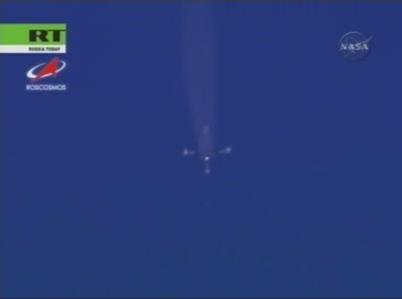R-7 rocket on:
[Wikipedia]
[Google]
[Amazon]
 The R-7 family of rockets (russian: Р-7) is a series of rockets, derived from the
The R-7 family of rockets (russian: Р-7) is a series of rockets, derived from the
 The Korolev Cross is a visual phenomenon observed in the smoke plumes of the R-7 series rockets during separation of the four liquid-fueled booster rockets attached to the core stage.NASA TV coverage of Soyuz TMA-12 launch As the boosters fall away from the rocket, they pitch over symmetrically due to aerodynamic forces acting upon them, forming a cross-like shape behind the rocket. The effect is named after Sergey Korolev; the designer of the R-7 rocket. When the rocket is launched into clear skies, the effect can be seen from the ground at the launch site.
The Korolev Cross is a visual phenomenon observed in the smoke plumes of the R-7 series rockets during separation of the four liquid-fueled booster rockets attached to the core stage.NASA TV coverage of Soyuz TMA-12 launch As the boosters fall away from the rocket, they pitch over symmetrically due to aerodynamic forces acting upon them, forming a cross-like shape behind the rocket. The effect is named after Sergey Korolev; the designer of the R-7 rocket. When the rocket is launched into clear skies, the effect can be seen from the ground at the launch site.
Rocket R-7
from S.P. Korolev Rocket and Space Corporation Energia, a Russian rocket and space contractor {{DEFAULTSORT:R-07 R-7 (rocket family), Space launch vehicles of the Soviet Union Soviet inventions Rocket families Space launch vehicles of Russia
Soviet
The Soviet Union,. officially the Union of Soviet Socialist Republics. (USSR),. was a transcontinental country that spanned much of Eurasia from 1922 to 1991. A flagship communist state, it was nominally a federal union of fifteen nation ...
R-7 Semyorka, the world's first ICBM. More R-7 rockets have been launched than any other family of large rockets.
When Soviet nuclear warheads became lighter, the R-7 turned out to be impractical as a ballistic missile, and there were no other heavy payloads with a military application. However, long-term development has made the rockets useful in the Soviet, and later, Russian space programmes. Their purpose shifted primarily to launching satellites, probes, manned and unmanned spacecraft, and other non-threatening payloads. The R-7 family consists of both missiles and orbital carrier rockets. Derivatives include the Vostok Vostok refers to east in Russian but may also refer to:
Spaceflight
* Vostok programme, Soviet human spaceflight project
* Vostok (spacecraft), a type of spacecraft built by the Soviet Union
* Vostok (rocket family), family of rockets derived from ...
, Voskhod and Soyuz Soyuz is a transliteration of the Cyrillic text Союз ( Russian and Ukrainian, 'Union'). It can refer to any union, such as a trade union (''profsoyuz'') or the Union of Soviet Socialist Republics (Сою́з Сове́тских Социалис ...
rockets, which as of 2022 have been used for all Soviet, and later Russian human spaceflights. The type has a unique configuration where four break-away liquid-fueled engines surround a central core. The core acts as, in effect, a "second stage" after the other four engines are jettisoned. These rockets are expendable.
Later modifications were standardised around the Soyuz design. The Soyuz-2 (rocket), Soyuz-2 is currently in use.
The Soyuz-FG was retired in 2019 in favour of the Soyuz-2.1a. R-7 rockets are launched from the Baikonur Cosmodrome, Plesetsk Cosmodrome, Guiana Space Centre (since 2011, see Soyuz at the Guiana Space Centre), and the Vostochny Cosmodrome (first launch 2016).
Summary of variants
All the R-7 family rockets are listed here by date of introduction. Most of the early R-7 variants have been retired. Active versions (as of 2022) are shown in green.Korolev Cross
See also
* 1957 in spaceflight * List of R-7 launches * Comparison of orbital launchers familiesReferences
* *External links
Rocket R-7
from S.P. Korolev Rocket and Space Corporation Energia, a Russian rocket and space contractor {{DEFAULTSORT:R-07 R-7 (rocket family), Space launch vehicles of the Soviet Union Soviet inventions Rocket families Space launch vehicles of Russia